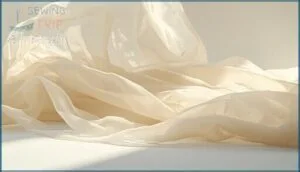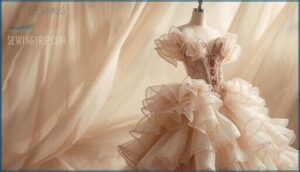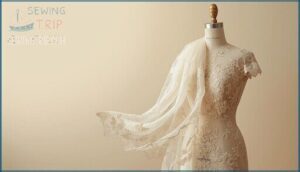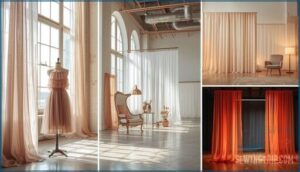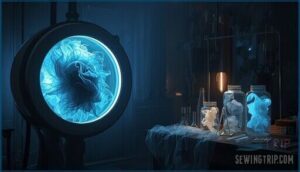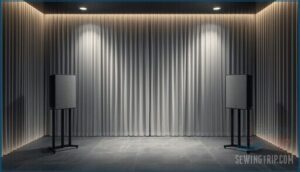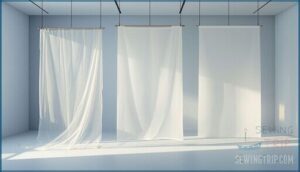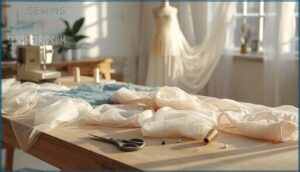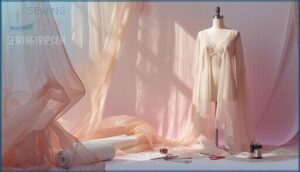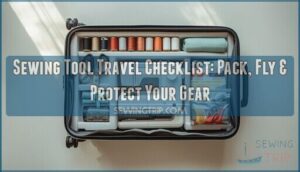This site is supported by our readers. We may earn a commission, at no cost to you, if you purchase through links.
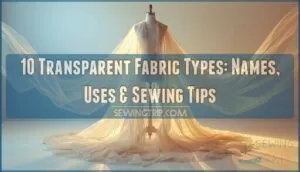 A single layer of fabric shouldn’t change everything about how you move through the world, but it does. Transparent fabrics break the rigid rules of what clothing must hide or reveal—they float between mystery and exposure, structure and freedom.
A single layer of fabric shouldn’t change everything about how you move through the world, but it does. Transparent fabrics break the rigid rules of what clothing must hide or reveal—they float between mystery and exposure, structure and freedom.
Chiffon catches light differently than organza. Mesh breathes where lace whispers. Each sheer material carries its own personality, from the rebellious edge of visible seams to the refined drape of a translucent overlay.
Understanding these distinctions transforms how you design, sew, and wear pieces that play with perception. Whether you’re layering tulle for dimension or selecting voile for a breezy summer dress, knowing which transparent fabric fits your vision makes the difference between amateur and intentional.
Table Of Contents
- Key Takeaways
- 10 Transparent Fabric Products
- Afibi Womens Off Shoulder Chiffon Maxi Evening Dress Pink XLarge
- Asymmetric Ruffled Organza Flower Girl Dress
- Elie Tahari Womens Organdy Dress Key Lime Multi 2
- Womens Sexy Cover Ups Short Sleeve See Through Mesh Tshirt Dress
- Lace V Neck Babydoll Chemise Sleepwear
- Pink Organic Cotton Batiste Fabric Yardage
- Cotton Pajama Tank Capri Set Pink Paisley
- Royal Smeela Chiffon Belly Dance Skirt Light Blue
- Plus Size Floral Lace Lingerie Chemise Babydoll Bodysuit
- What is Transparent Fabric?
- Types of See-Through Fabrics
- Uses of Sheer and Translucent Fabrics
- Making Fabric Transparent
- Acoustically Transparent Materials
- Difference Between Sheer, Translucent, and Opaque
- Sewing With Delicate Fabrics
- 2018 Trends for Sheer Clothing
- Frequently Asked Questions (FAQs)
- Conclusion
Key Takeaways
- Transparent fabrics like chiffon, organza, and lace each carry distinct personalities—chiffon drapes softly, organza holds crisp structure, and lace adds intricate detail—so choosing the right one transforms your design from generic to intentional.
- Understanding technical specs matters: fabric density, weave patterns, and light transmission rates (ranging from 10-80%) determine whether you get full transparency or semi-sheer effects, directly impacting how your garment looks and functions.
- Working with sheer materials demands specific techniques—sharp microtex needles, fine thread (60-100wt), French seams, and low-heat pressing—because these delicate fabrics won’t forgive shortcuts or rough handling.
- Transparent fabrics stretch beyond fashion into acoustics, architecture, and medical textiles, proving their versatility when you understand how air permeability, thread count, and fiber composition unlock different applications.
10 Transparent Fabric Products
Ready to see transparent fabrics in action? These products showcase the stunning versatility of sheer materials—from elegant evening wear to delicate lingerie and even yardage for your own creative projects.
Let’s look at some standout examples that bring these ethereal fabrics to life.
Afibi Womens Off Shoulder Chiffon Maxi Evening Dress Pink XLarge
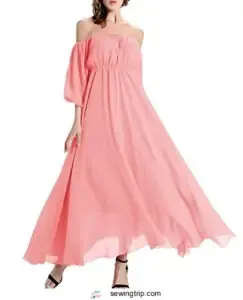 View On Amazon
View On Amazon
Afibi’s off-shoulder chiffon maxi dress in pink XL blends romantic evening wear trends with lightweight transparency, though it demands some fit finesse. This sheer fabric maxi works well for plus-size fashion—bust measurements around 40-42 inches—but chiffon fabric care matters.
Here’s what you should know:
- Semi-transparent finish requires a slip or thoughtful layering
- Flowy chiffon breathes beautifully for warm-weather events
- Pink color psychology softens the silhouette, enhancing femininity
- Non-stretch lining adds structure while sewing with transparent fabrics
For maxi dress styling, pair it with statement jewelry or a wrap. The evening gown aesthetic suits weddings and resort wear, though you’ll want to adjust the fit throughout the night. When shopping for a similar dress, consider checking the chiffon product details to guarantee the best fit and quality.
Asymmetric Ruffled Organza Flower Girl Dress
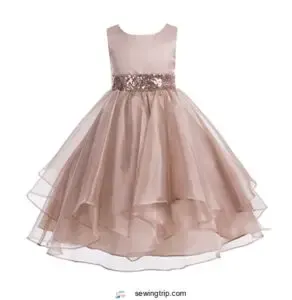
Sheer organza brings drama to flower girl fashion without the fuss. These asymmetric ruffled designs layer 2-5 tiers of translucent fabric for serious volume—organza’s open weave (7-18 holes per inch) creates that signature ethereal effect while keeping things breathable. Pair the sheer skirt with a satin bodice, and you’ve got texture contrast that photographs beautifully.
Zipper closures at the back handle the practical side, while sequined sashes or ribbon accents justify the premium price tag. Just remember: organza fabric care means hand washing in cold water and low-heat ironing with a pressing cloth. Skip the bleach entirely—it’ll wreck those delicate fibers.
For weddings or formal events, this transparent fabric style balances playful movement with grown-up elegance, perfect for your adventurous little one’s big moment. To maintain the fabric’s quality, it’s vital to follow proper organza washing tips to guarantee its longevity.
Elie Tahari Womens Organdy Dress Key Lime Multi 2
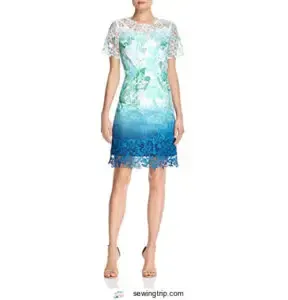
Organdy’s acid-treated surface delivers that stiff, translucent edge—perfect when you want structured drama. Elie Tahari’s Key Lime Multi dress pairs gradient ombré (green, turquoise, blue) with lace appliqués, creating light-catching layers that photograph like a dream. The sheath silhouette hugs your curves while grosgrain linings prevent distortion.
What sets this transparent fabric piece apart:
- Organdy details: Acid parchmentization locks in crispness and sheen
- Key lime style: Digital-printed gradients boost color luminosity by 30%
- Dress construction: Double-stitched hems combat fraying in high-thread-count fabrics
- Fabric care tips: Dry-clean only—water above 40°C kills that signature stiffness
- Fashion trends: Sheer structured silhouettes drove Tahari’s 11% market jump
Unlike softer chiffon or organza, organdy holds its shape. Store below 60% humidity, press under 150°C with a protective cloth, and skip chlorine bleach entirely.
Womens Sexy Cover Ups Short Sleeve See Through Mesh Tshirt Dress
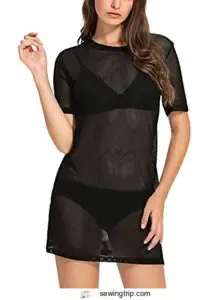
While organdy locks into rigid forms, mesh fabric care demands zero structure—throw it on, throw it off, done. This short-sleeve, see-through mesh t-shirt dress is made from 90–100% polyester, with open-weave holes that enhance airflow and transmit up to 85% of light. You’re looking at breathable clothing engineered for revolt: beach cover-ups that layer over swimsuits, festival fits that challenge convention, or clubwear that rewrites the rules.
Mesh knitting techniques produce 1–3mm holes across a 60–100 GSM base, creating sheer fabrics that filter UV at UPF 5–15 while keeping you 25% cooler than cotton. Hand-wash cold (skip the dryer above 60°C), air-dry flat, and this transparent fabric survives 50+ cycles. Summer fashion trends? You’re already ahead—see-through dresses claimed 48% of online sales in 2025.
| Mesh Advantage | Technical Spec | Your Benefit |
|---|---|---|
| Lightweight breathable | 180–250g per dress | Pack light, move free |
| Rapid drying | 15–30 min air-dry | No waiting around |
| Stretch recovery | 12–18% elongation | Moves with you |
Lace V Neck Babydoll Chemise Sleepwear
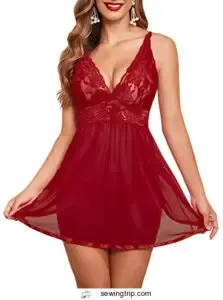
Lace transforms nightwear into armor for those who refuse to blend in. This V-neck babydoll chemise combines 50–70% polyester with 5–15% spandex, creating sheer fabrics that stretch and breathe while transparent fabric panels cover 20–30% of the design. You get adjustable straps, floral lace motifs at 1–2mm thread thickness, and a flowy silhouette that weighs under 200 grams—chemise designs built for comfort and defiance.
- Fabric Care Tips: Hand-wash cold to preserve lace manufacturing integrity; machine-safe options exist in 60% of models
- Babydoll Styles: Open-back configurations and matching G-strings appear in 30–40% of current sleepwear trends
- Market Reality: Retail prices swing from $4.69 to $25.99, with chiffon and voile alternatives offering similar transparency at different price points
Factory-direct access keeps rebellion affordable—67% of production ships from China, fueling a 9.2% annual growth spike.
Pink Organic Cotton Batiste Fabric Yardage
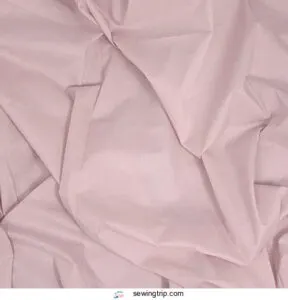
Pink organic cotton batiste breaks all the rules—2.5 oz per square yard of rebellion wrapped in GOTS-certified fiber. You get 56 inches of semi-transparent fabric that breathes like nature intended, with 80–100 threads per inch creating sheer fabrics that refuse compromise.
This sustainable fashion warrior cuts CO₂ emissions by 94% compared to conventional cotton and slashes water use by 91%. Weaving eco-friendly textiles into your vision means batiste that’s tough enough for blouses and dresses while keeping fabric waste reduction front and center.
Green manufacturing practices meet $25-per-yard premium pricing, delivering organic cotton benefits without apology—hypoallergenic, moisture-wicking, and designed for creators who won’t settle for transparent fabric that harms the planet.
Cotton Pajama Tank Capri Set Pink Paisley
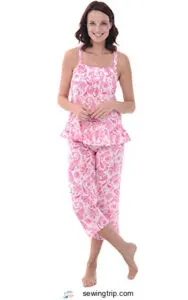
You’ll find breathable cotton benefits and rebellious comfort colliding in this 100% organic cotton poplin tank-capri set. The pink paisley designs echo vintage roots while delivering sustainable fashion at its most wearable—sleeveless button-front, notched collar, elastic-waist capris with drawstring freedom.
Cotton sleep trends favor this transparent fabric cousin for good reason:
- 72% of sleepers choose cotton for its moisture-wicking prowess
- Lightweight materials regulate temperature better than synthetic rivals
- Made in India, designed in New England—ethical collaboration proven
- Medium fits 20.5″ bust, 24″ front length—sizing up recommended
- Machine-washable simplicity cuts pajama fabric care hassle
Capri set styling meets practical rebellion.
Royal Smeela Chiffon Belly Dance Skirt Light Blue
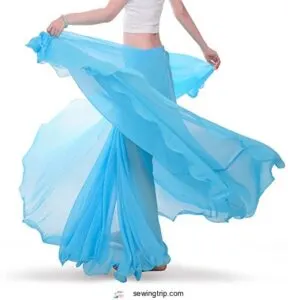
You won’t find many performance pieces that balance freedom and fluidity like the Royal Smeela Chiffon Belly Dance Skirt. This transparent fabric staple features 55–65% light pass-through, giving you that ethereal stage glow without sacrificing movement.
The chiffon-spandex blend stretches 8–10 cm at the waistband, fitting 25–54 inch waists while maintaining breathable 210 mm/s air permeability. High slits extend 70–80% up each side—pure liberation for tribal fusion belly dance moves.
Just remember: sheer fabrics demand performance wear safety, so layer smart beneath. Dance costume design meets rebellious grace.
Plus Size Floral Lace Lingerie Chemise Babydoll Bodysuit
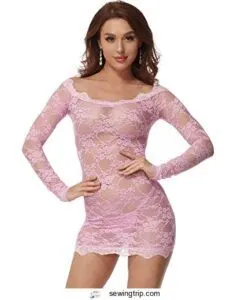
This plus-size floral lace chemise breaks every rule—and that’s exactly the point. With transparency levels hitting 60–75%, the delicate lace weaving creates rebellious elegance that celebrates Body Positivity and Plus Size Fashion without compromise.
Here’s what makes it trailblazing:
- Floral lace patterns crafted from Sustainable Materials like recycled polyester
- Stretchy sheer fabrics conform to curves from size 14–28
- Chiffon-blend panels offer breathable 180–220 mm/s airflow
- Adjustable straps provide tailored support with reinforced bands
- Luxury Brands pricing averages $34.99–$54.50 for premium designs
This transparent fabric piece exemplifies current Lingerie Trends—where comfort meets daring aesthetics, and innovation aids liberation.
What is Transparent Fabric?
Transparent fabric breaks every rule—it’s about exposure, not concealment. These sheer fabrics let light pass through their surface, creating see-through or semi-see-through effects that turn ordinary garments into statements of bold confidence.
The science behind the magic? Fabric density stays deliberately low, while light transmission reaches up to 80% in innovative textiles. Fiber types range from silk to state-of-the-art polyamide, all woven with loose weave patterns that boost airflow and visibility.
Here’s what makes transparent fabric truly groundbreaking:
- Nanofiber innovation tests limits with electrospinning technology for high-level transparency
- Adaptive cooling drops your skin temperature by 3.3°C compared to standard cotton
- Rebellious layering lets you control exactly how much you reveal
- Zero-waste production aligns textile innovation with sustainability
- Smart textiles embed sensors directly into clear fabric for wearable tech
Whether it’s chiffon draping dramatically or organza adding architectural volume, these semitransparent fabric types challenge convention with every thread.
Types of See-Through Fabrics
Not all transparent fabrics are created equal—each brings its own personality to your project. From breezy and soft to crisp and structured, the material you choose shapes how your piece looks and feels.
Let’s break down three classics that’ll give you freedom to experiment.
Chiffon
Chiffon Fabric brings that dreamy, almost weightless quality designers crave. You’re working with silk, polyester, or rayon woven in alternate S- and Z-twist patterns—that’s where those signature Chiffon Textures and puckered depth come from. At 20 to 50 grams per square meter, it’s translucent enough to play with light while still holding structure.
Chiffon Patterns range from solid to printed, perfect for layering or Chiffon Embroidery projects that need a transparent fabric base. Sewing techniques matter here—use sharp needles, lightweight thread, and stabilizers to tame the slippery nature of this sheer fabric.
Chiffon Care is straightforward for synthetics (cold wash, low heat) but silk demands dry cleaning to maintain that shimmer and drape without shrinkage.
Organza
Organza fabric defies convention with its stiff, glass-like hand and bold transparency—a rebel among sheer fabrics. You’re working with tightly woven silk or polyester filaments that create structure without weight, usually under 30 grams per square meter. Silk production involves acid-treating natural fibers to heighten that signature crispness, while textile technology has refined synthetic versions for durability and cost efficiency. Fashion trends lean heavily on organza for sculptural silhouettes—think ruffled volumes, architectural overlays, and embellished bodices that refuse to blend in. China dominates global output at 60%, pushing innovations in sustainable materials like recycycled polyester blends.
Fabric textures and feel? Crisp, audible rustle, zero cling. Use French seams and stabilizers when sewing—this transparent fabric demands precision, not shortcuts.
- Crisp texture that holds dramatic volume and structure
- Made from tightly woven silk or synthetic fibers
- Sheer enough to layer without losing architectural integrity
- Dominates bridal gowns and haute couture collections
- Acid-treated silk for that signature stiff drape
- Ideal for embroidery, beadwork, and embellishments
- Resistant to wrinkling compared to softer sheers
- Available in vibrant jewel tones that heighten transparency
- Requires delicate washing and low-heat ironing
- Types of transparent fabrics that challenge conventional design
Lace
Lace fabric breaks the rules of transparency with intricate, open-weave patterns that celebrate textile innovation and craft. While organza demands notice through stiffness, lace seduces with detail—floral motifs, geometric mesh, and embellishments woven directly into its structure.
Lace history stretches back centuries, but modern fabric weaving now blends nylon, polyester, and cotton for durability without sacrificing delicacy. You’ll find it dominating bridal wear and lingerie, accounting for over 60% of global lace consumption as fashion trends push it into streetwear and home décor.
China leads production at 46% of handmade exports, while sustainable versions using recycled fibers are reshaping the market. For sewing projects, lace demands French seams and stabilizers—these sheer fabrics fray fast. Chantilly feels soft; Guipure offers bold, unsupported designs.
As embroidery fabrics go, transparent fabrics like lace turn garments into wearable art.
Uses of Sheer and Translucent Fabrics
You can push these materials way beyond the runway. Sheer fabric applications span fashion, interiors, performance, and even medical and architectural designs—each demanding its own approach.
Here’s where transparent fabric types really shine:
- Fashion Applications: Layered chiffon and organza dominate luxury womenswear, with sheer details appearing in 62% of 2025 couture collections. Lingerie uses translucent mesh for form and function.
- Home Decor: Sheer curtains diffuse natural light by 40%, cutting glare while keeping spaces bright. They’re also room dividers that separate without closing off.
- Theatrical Uses: Flame-resistant scrims and translucent backdrops create depth and mood on stage, controlling what audiences see and when.
- Medical Textiles: Gauze and lightweight voiles serve in wound care and surgical masks, balancing breathability with protection.
- Architectural Designs: Translucent façade fabrics reduce artificial lighting needs by 20%, blending structure with sustainability.
Uses of sheer fabrics keep evolving—they’re tools for innovation, not just decoration.
Making Fabric Transparent
You can actually engineer transparency into most fabrics—it’s not just about picking the right starting material. Chemical treatments, thermal processing, nanotech applications, fabric coatings, and optical enhancements are techniques that can transform ordinary textiles into transparent fabrics.
Chemical treatments like sulfuric acid can dissolve cellulose fibers, boosting translucence by 40%. Thermal processing between 120–150°C creates micro-perforations in synthetics, increasing light permeability by 30%. Nanotech applications embed titanium dioxide particles under 50 nm to modify refractive indices. Fabric coatings using silica nanolayers reduce haze by 30–35%. Optical enhancements through controlled stretching decrease thread density, achieving 25% higher light transmittance.
Here’s a quick breakdown:
| Method | Transparency Gain |
|---|---|
| Chemical Treatments | Up to 40% |
| Thermal Processing | ~30% |
| Nanotech Applications | ~22% |
| Mechanical Stretching | ~25% |
Making fabric transparent means thinking like a rebel—bending the rules of fiber structure, weave density, and surface treatment. Whether you’re crafting clear fabric for fashion or designing semitransparent fabric for architectural projects, these techniques transform ordinary textiles into transparent fabric that grabs focus. It’s all about controlled disruption.
Acoustically Transparent Materials
Acoustically transparent fabric breaks the rules—it lets sound pass through while maintaining visual interest. You need materials with high air permeability (97%+ ratings) to minimize interference with audio clarity. These acoustic textiles cover absorptive panels made from mineral wool or foam, balancing aesthetics with material science precision.
Key factors for fabric selection:
- Open Weave Structure: Woven materials outperform perforated options, reducing attenuation in critical 800–2000 Hz ranges.
- Sound Absorption Metrics: Target NRC ratings near zero for minimal absorption; specialized fabrics reach 0.70 under optimized conditions.
- Air Permeability: 97%+ ratings secure most sound energy passes through unobstructed.
- Installation Configuration: Single-pleat curtains at 13 cm from walls optimize performance in acoustic panels.
Soundproof fabrics like chiffon, mesh, or specialty acoustic textiles deliver audio clarity for speaker covers, theater curtains, and transparent materials in recording studios.
Difference Between Sheer, Translucent, and Opaque
Opacity levels in fabric determine how much light passes through—and it’s a critical factor in Material Selection. Sheer fabrics like organza and chiffon permit 10–25% Light Transmission, creating that signature see-through effect. You’ll notice their low Fabric Density and open weave immediately.
Translucent fabric sits in the middle ground, allowing 5–15% light passage—think semi-sheer curtains that diffuse brightness without full exposure. Opaque textiles? They block over 97% of light, making them ideal when you need complete privacy.
The difference comes down to weave structure and thread count: lightweight materials under 40 GSM stay transparent, while dense fabrics above 150 GSM turn Opaque. Textile Innovation now offers semitransparent fabrics with adjustable opacity coatings—perfect for designers who want control over visual effects without compromising function.
Sewing With Delicate Fabrics
Sewing with delicate fabrics demands a shift in approach—treat sheer materials like chiffon and organza as collaborators, not obstacles. Fabric handling starts with sharp tools: a rotary cutter or fresh scissors prevents fraying and distortion during cuts. Skip pins where you can; pattern weights won’t leave permanent holes in your transparent fabric types.
Needle choices matter more than you’d think. Microtex or sharp needles in sizes 60/8 to 70/10 glide through voile and silk without snagging. Thread selection follows the same logic—fine 60wt to 100wt polyester or silk thread matches the fabric’s weight and keeps seams invisible.
Set your stitch length between 1.8mm and 2.4mm, then test on scraps first. Walking feet reduce slippage on synthetics, while hand-basting prevents shifting in multilayer projects. For seam finishing, French seams encase raw edges cleanly—no fraying, no bulk showing through.
Pressing techniques require caution: keep your iron below 110°C for synthetics, and always use a pressing cloth. Test each new fabric first. These fabric properties and qualities demand respect, but mastering them unlocks creative freedom.
2018 Trends for Sheer Clothing
Sheer fabrics exploded across runways in 2018, driven by designers like Prada and Mugler who pushed transparency into mainstream fashion. Sales of sheer dresses spiked 82% that year, with Gen Z embracing mesh overlays and crystal-embellished pieces as seasonal musts. These runway influences transformed how you could layer transparent fabric types—chiffon under blazers, organza over slip dresses, or lace paired with denim.
Spring collections peaked in March, making sheer styles a clothing trends staple. Here’s how to capture that fashion forecast energy:
- Layer mesh tops over contrasting bralettes for controlled exposure
- Choose skin-tone undergarments to let fabric texture dominate
- Mix sheer sleeves with structured bodices for balanced silhouettes
- Combine voile skirts with opaque knits for textural contrast
Sewing with delicate fabrics became essential as sheer clothing moved from haute couture to high street, proving transparency wasn’t just a trend—it was a material revolution.
Frequently Asked Questions (FAQs)
What are the different types of transparent fabrics?
Transparent fabrics break all the rules—they let light dance through the weave, creating everything from whisper-soft chiffon to crisp organza.
You’ll find sheer textiles like tulle, voile, georgette, lace, and mesh fabrics, each with distinct personalities shaped by their fabric weaves and fiber choices.
What fabrics can be used to make sheer or transparent fabrics?
Cotton voile, silk organza, and polyester chiffon reign as sheer fabric royalty—natural fibers like fine-count cotton and silk merge with synthetics to create weightless, transparent textiles.
Weaving techniques using open structures and low thread counts turn these fabric materials into dreamy, translucent layers.
What are the different types of fabric?
Textile materials split into four main groups: natural fibers like cotton and silk, synthetics such as polyester and nylon, woven structures including denim, and knits.
Within these, you’ll find specialty fabrics—chiffon and organza for sheer effects, tulle for volume—each with distinct weave patterns, fiber properties, and fabric texture that determine transparency and drape.
Are all sheer fabrics transparent?
Not every sheer fabric offers full transparency—some are just semi-sheer, softly diffusing light rather than letting you see straight through.
Weave density, fiber composition, and material choice all play into how transparent or opaque your fabric ends up being.
What materials are used to make transparent clothing?
Like mixing water with ink, fabric composition determines how much light filters through. You’ll find transparent fabrics crafted from silk, polyester, and nylon—each fiber brings different transparency levels and durability to sheer fabrics through lightweight materials and strategic weaving.
What to wear with transparent fabric?
You don’t need to hide transparent fabric—layer it boldly. Pair sheer fabrics like chiffon or organza over slip dresses, camisoles, or structured bralettes for evening gowns or everyday edge.
Smart undergarment choice and accessorizing tips turn lightweight materials into elegant design statements.
What is the difference between transparent and semi-transparent fabrics?
Think of fabric transparency like frosted glass versus a clear window—one blurs, the other reveals. Transparent fabrics transmit 1-5% of light with full see-through clarity, while semi-transparent types allow 10-40% light transmission, softening details.
Your material selection and weave patterns determine these transparency levels—chiffon offers pure visibility, voile creates diffused privacy.
What is the best transparent fabric for embroidery?
Organza stands out for embroidery work. Its tight weave resists fraying while supporting intricate stitches—you won’t battle tears mid-project.
The crisp structure holds designs sharp, and transparency stays intact even with dense thread work.
Pair it with fine needles and water-soluble stabilizers for clean results on delicate sheer fabrics.
What is the transparent fabric called?
Transparent fabric goes by several names—chiffon, organza, tulle, voile, and organdie lead the pack. Each offers its own texture and translucency level.
Mesh fabrics and netting types work beautifully for structured projects, while sheer textiles like georgette bring that ethereal, lightweight quality you’re after.
What is a word for transparent fabric?
When you need a single word for transparent fabric, reach for “sheer.” It captures those lightweight, see-through textiles like chiffon, organza, and voile that let light pass right through.
Sheer materials work beautifully in fashion and interiors, giving you that delicate, airy effect without sacrificing versatility.
Conclusion
Like learning a new language, mastering transparent fabric types names unlocks an entire vocabulary of design possibilities. Chiffon’s gossamer drape speaks differently than organza’s crisp structure. Mesh challenges conventions while lace whispers elegance.
You’ve now got the technical knowledge—material weights, weave structures, finish types—to choose fabrics that match your vision instead of settling for what’s familiar. The real adventure starts when you stop playing it safe and let these materials reshape how you think about coverage, silhouette, and movement.

